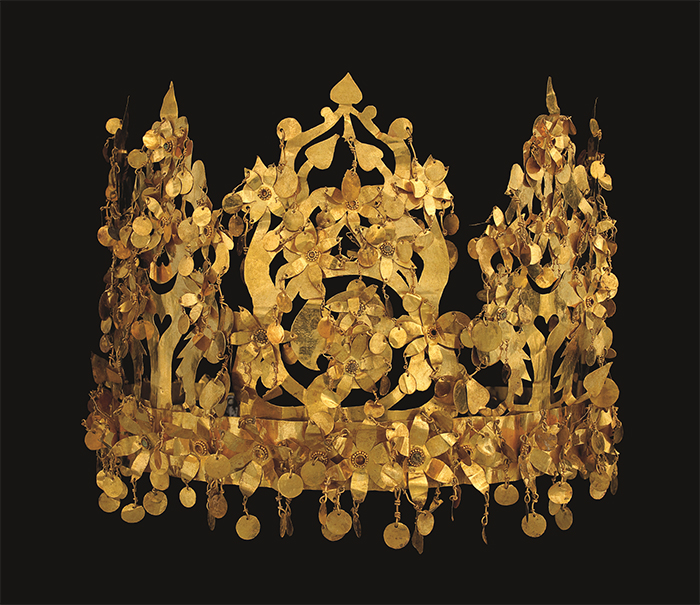
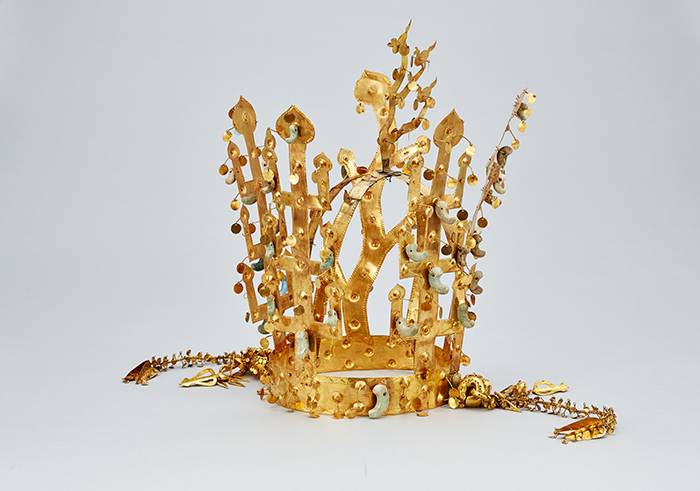
Similarities between a gold crown from the sixth tomb at the Tillya Tepe archeological site in Afghanistan (top) and a gold crown from the Seobongchong Tomb that dates back to ancient Silla (57 B.C.-A.D. 935) lead some modern-day academics to posit that trade and cultural exchanges took place between ancient Korea and Afghanistan.
"Treasures of Afghanistan" recently opened at the National Museum of Korea, the first time for 231 artifacts from the National Museum of Afghanistan to be on display in Korea. Opening on July 5, the exhibit will run until Sept. 4 at the National Museum of Korea in Seoul, and from Sept. 27 to Nov. 27 at the Gyeongju National Museum.
Afghanistan is a landlocked country surrounded by Tajikistan, Uzbekistan, Turkmenistan, Iran and Pakistan. Located in the middle of Asia, the country was the center of the Silk Road and was a crossroads that connected Europe to the west, China to the east and India to the south.
The exhibit is composed of four sections, classified by historic site and in chronological order: Tepe Fullol, Ai-Khanoum, Tillya Tepe and Begram.
The first section displays Bronze Age artifacts from about 2000 B.C. found at Tepe Fullol. Surrounded by rugged mountains higher than 3,000 meters, the historic site was once fertile agricultural fields and quite prosperous, as can be told from the trade in azure stones. The site was unveiled in 1966 when a local resident found some gold and silver items. The geometrical patterns and the drawings of animals on the gold vessels give clues to possible cultural exchanges that took place between Mesopotamian and Indus civilizations.
The second section of the exhibit features artifacts from Ai-Khanoum, a site in northern Afghanistan that first developed after Alexander the Great's wars in the fourth century B.C. Located near the river Amu Darya, the historic site was home to Greek urban elements, like temples, palaces, stadiums, libraries and semicircular theaters. Greek letters and mythologies were also found at the site, while artifacts from India were found as well, giving evidence to the site's ancient internationality. The architectural style there shows Hellenistic characteristics that combine Greek and East Asian elements.
The third section, and the highlight of the exhibit, displays artifacts found at Tillya Tepe. Excavated in 1978 by Soviet archeologist Viktor Sarianidi, the grand discovery attracted as much attention from all around the world as did Tutankhamun's tomb. Corresponding to its literal meaning of "golden hill," five tombs of women and one tomb of a man seemingly built around the first century B.C. were unearthed at the site. Gold ornaments, called Bactrian gold, show the active trade that took place between nomads and cities across broad areas of central Asia. The global, diverse culture that existed there integrated many elements of Greek, Roman, Indian and Scythian-Siberian civilizations. In particular, a gold crown found in the sixth tomb has been in the Korean academic spotlight as some scholars think its design is related to designs seen in gold Silla crowns.
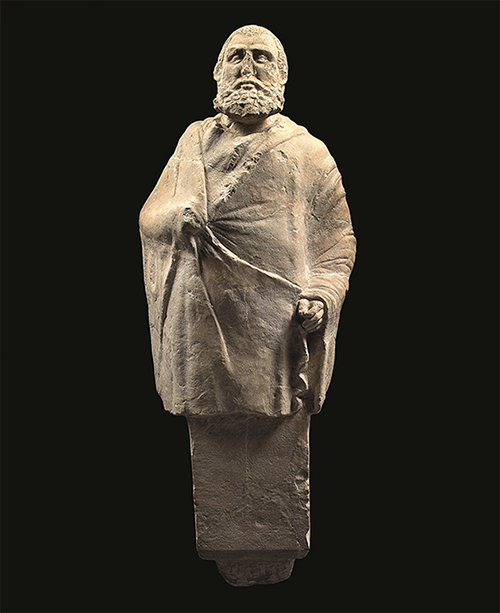
A stone statue of Hermes from the second century B.C. is found in Ai-Khanoum.
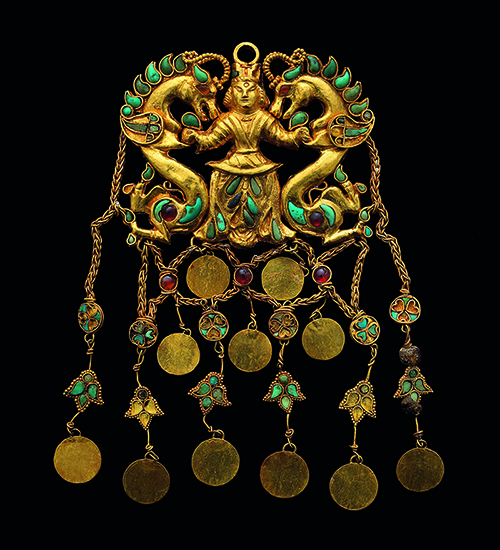
A gold pendant inlaid with dragon and human forms is found in the second tomb at Tillya Tepe and dates from the first century.
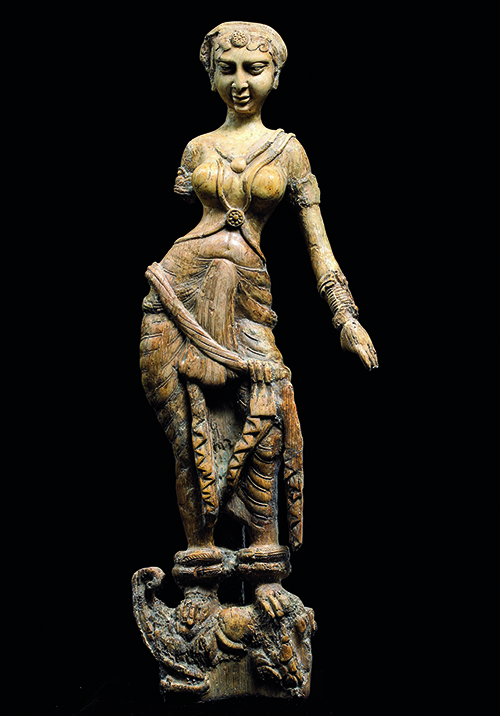
A statue of an ivory goddess standing on a makara, a mythical Hindu sea creature, is from a site in Begram dating from the first century.
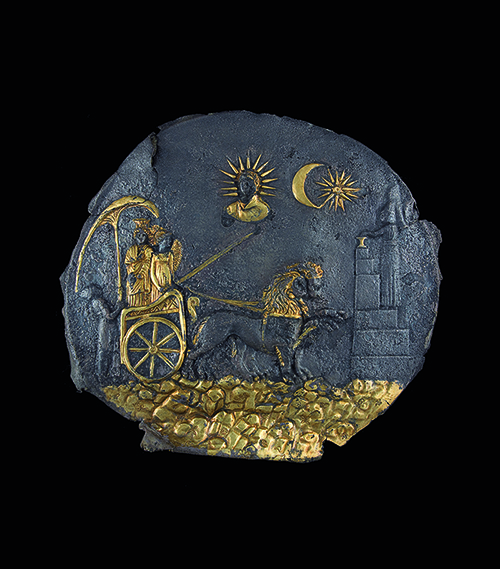
A round panel showing the goddess Cybele is made out of silver and gold and is gold-plated. It's from Ai-Khanoum and dates to around the third century B.C.
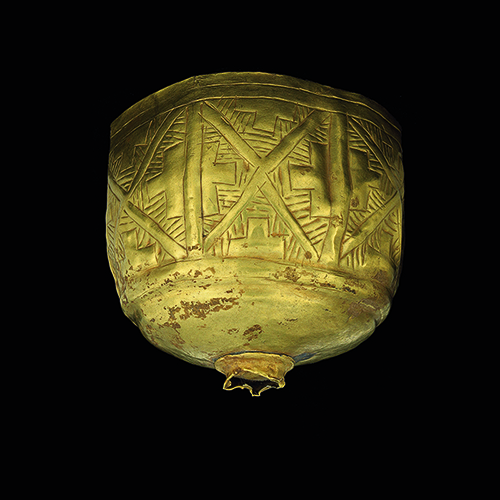
A gold vessel with geometric patterns is from a site near Tepe Fullol.
The fourth section of the exhibit features artifacts from Begram, the prosperous capital of the Kushan Empire. Being only 60 kilometers from the Afghan capital of Kabul, Begram was also known as Kapici when it was visited by the Tang monk Xuanzang (현장, 玄奘) in the seventh century. Many artifacts, like glass wares, bronze wares, plasters and lacquer, were found at what is believed to be an old palace site that dates from the first century. Artifacts uncovered there show influences from India, Rome, Greece and China. Witnessing a city that was once prosperous through trade along both the Silk Road and along seaborne routes, visitors can see first-hand the exchanges that took place between the East and the West.
On a world tour that started in 2006 at the Guimet Museum in Paris, the ancient Afghan artifacts have since traveled to 18 museums in 11 countries, including the National Gallery of Art in Washington, D.C., the Metropolitan Museum in New York and the British Museum in London. Korea and the National Museum of Korea are now the 12th country to host the exhibit, marking its 10th year on the road. As part of the exhibit, entries in a special photography exhibit titled "The Afghanistan We Are Proud Of," in partnership with UNESCO's Afghanistan branch, are also on display, proving a look at the past, present and future of Afghanistan.
By Wi Tack-whan, Chang Iou-chung
Korea.net Staff Writers
Photos: National Museum of Korea
whan23@korea.kr